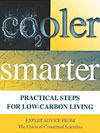All of the authors on the team are blogging about the findings in our new book, Cooler Smarter: Practical Steps for Low-Carbon Living. So today I’m turning this space over to my colleague and one of the book’s authors, Suzanne Shaw.
Suzanne Shaw, Director of Communications, Union of Concerned Scientists — When you suggest changes that can help your workplace save money, people are likely to listen. And as we demonstrate in our new book, reducing global warming emissions can produce big savings. Here’s what you need to know to encourage your employer along an energy-efficient, low-carbon path.
Low Emissions = Big Savings
 This is part of a series on Cooler Smarter: Practical Steps for Low-Carbon Living.
This is part of a series on Cooler Smarter: Practical Steps for Low-Carbon Living.
Many businesses large and small are waking up to the economic benefits of reducing their energy use and emissions. For example, the chemical giant DuPont was an early leader. Between 1990 and 2006, the company invested in more energy-efficient processes and equipment, renewable energy, and other emissions-reducing approaches. It cut worldwide heat-trapping emissions to 72 percent below 1990 levels and reduced energy use by 7 percent even while its production expanded 30 percent. As a result DuPont saved roughly $2 billion in energy costs. But you don’t have to be a huge corporation to realize significant savings.
In Cooler Smarter we talk about Tom Bowman, the owner of Bowman Design Group, a small company that designs exhibits for corporations and museums. After designing an exhibit on climate change for the National Academy of Sciences, Tom decided he wanted to address global warming in his work life. After getting an energy audit, he redid his office lighting, bought power strips to turn off equipment at night, and installed more energy-efficient equipment, including an air-conditioner. He also traded in the company SUV for a hybrid Prius. He estimates he reduced his company’s emissions by 13 tons and is saving about $9,000 annually in the process.
Wouldn’t it be great if you could get your boss to think like Tom?
Start with Energy Savings
Making effective and sustainable climate choices often means doing more with less—exactly the type of thinking that helps businesses maximize their profits.
Ask around to see if energy savings efforts underway are already at your workplace. If so, join the effort. If not, you might offer to contact your utility (on your lunch break) to see if they provide free or low cost energy audits. At a larger corporation, you might list the tasks performed by your business unit, brainstorm how you could reduce its use of energy or resources, and present your ideas to your supervisor as money savers. Make sure to include a story or two like the ones above to showcase how other businesses are making wise and profitable energy choices.
Measurement Is Key
I’ll admit it: I am one of those people who will measure anything if it will give me some payback. I’ll happily sweat on a stair machine just so I can watch the calories burn. I’m a sucker for GPS. I’ve even counted out my paces on two separate routes to the same destination so I can take the shorter walk. I know it sounds a little extreme (my husband makes fun of me all the time), but the truth is, if you want to know whether you’re making progress, you need to know where you started. That’s definitely true when it comes to energy, emissions, and the workplace. Ideas are great, but measuring impact is critical if you’re going to prove the value of an effort.
Here at the Union of Concerned Scientists, we’ve been monitoring our energy use since the 1990s and conducting an annual carbon inventory since 2002. The information has helped us learn and continue to make steady progress. Most recently, by measuring efforts over time and deploying the best strategies, we were able to cut our total carbon emissions by almost 30 percent (28.8) between 2008 and 2011.

Here, staff in the Washington, D.C. office, conduct a meeting via video conference with Cambridge staff to cut down on energy-intensive inter-office travel. Photo by Emily Robinson.
If you’d like to learn more about building a low-carbon workplace, pick up a copy of Cooler Smarter. It provides many examples of businesses large and small making great strides in driving down their emissions, gives you practical advice on how you can be a catalyst for change at work, and tackles important issues from greenwashing to transparency.
